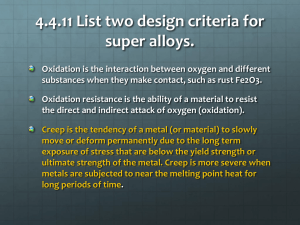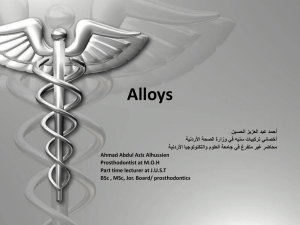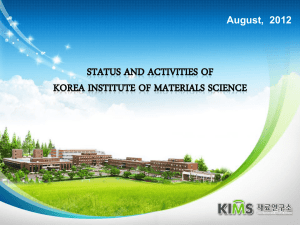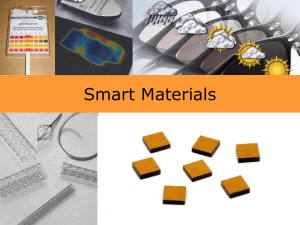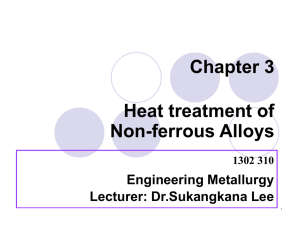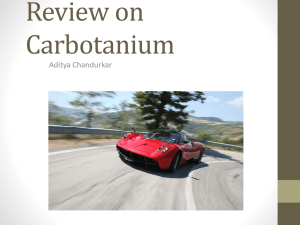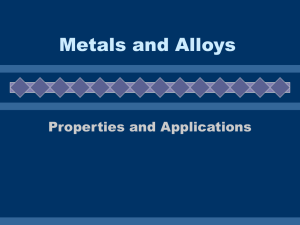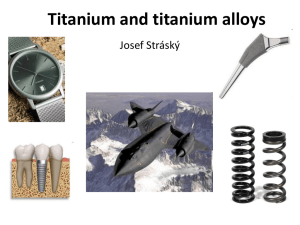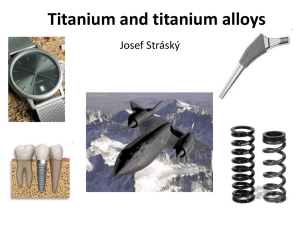Distribution of dental alloys
advertisement
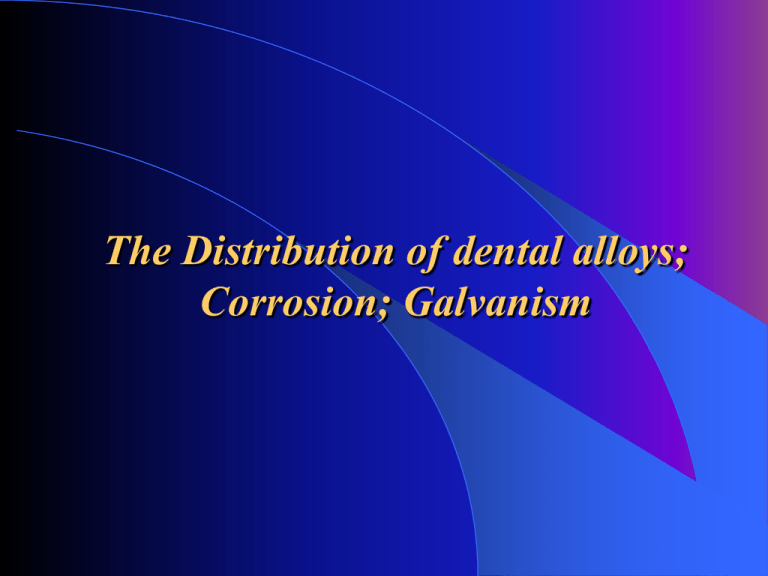
The Distribution of dental alloys; Corrosion; Galvanism Introduction: - the dental prothese are not maked from pure metal - for the dental purpose are used the dental alloys - the composition of individual metal is so that the properties of whole alloy was to the best advantage Development of dental alloys: - the first cast construction were discovered as the 18. century - The development of metal alloys arrived at the ending of 19. Century, when Mr. Bing constructed the first inlay°s bridge - at the 1880 year was characterised Richmond°s crown - at the 1883 y. Dexter construsted first removable bridge - at the 1886 y. Starr constructed the first bridge with telescopic crown - at the 1899 y. Staiton constructed first clasic flushing bridge - at the 1890 y. Parr constructed first removable partial denture with clasps Distribution of dental alloys: 1/ The alloys with the high content of aurum and platinum ( ISO 1562) 2/ The alloys with flat content of aurum and platinum, they are the alloys of argentum and palladium ( ISO 8891) 3/ The alloys of general metals ( cobalt, nickel ) ( ISO 6871) 4/ The alloys for ceramic burning ( titanium too) ( ISO 9693) 5/ The alloys as a aluminium bronze - the main criterium for this distribution and for assigning of ISO standard is hardness of material - the hardness of dental material can characterised by the Vickers and by the Brinell 1/ The distribution of gold alloys: Alloys of type 1: - flat mechanical stability ( smooth alloys ) - they are indicate for lightly mechanical weighted, e.g. inlays - they are the alloys with high content of aurum (87%) and lower content of others components as a cooper (4%), argentum (9%) - the hardness is 47-70 HB Alloys of type 2: - they are chracterised by the middle hardness - they are indicated for individual crowns and small bridges - the hardness is 80-90 HB - these typical alloys of this type have a high content of cooper (8%) and palládium (2,5%) 1/ The distribution of gold alloys: Alloys of type 3 - they are the alloys with a high hardness - they can be indicate for a mechanical very weighted inlays and large bridges - hardness is 95-115 HB - they content more cooper (10%) and palladium (3%) Alloys of type 4 - they are extra strong - they are the best for large bridges, for metal construction of removable partial denture, attachments - the hardness is 130-160 HB Alloys of aurum-pllatinum( ISO 1562): - for they is characterised, that they have no cooper - pllatinum does high of resistance - the chemical resistance is similar as a resistance of pure aurum - they are indicated for large bridges - they contetnt of aurum 75-90 %, 8-19% pllatinum, 4-10 % palladium, iron, iridium Alloys of aurum-pllatinum( ISO 1562): - iridium easy oxidate and make adhesion to the ceramic - palladium has a high temperature of melting, higher mechanical resistence and lower price - disadvantage is that palladium discolors the yelllow color of aurum - so these alloys have a white color defiance high content of aurum - typical color of these alloys after oxidation is grey or brown-grey 2/ The alloys with flat content of aurum and platinum , alloys of argentum-palladium( ISO 8891): - the basic metal of these alloys is argentum (60-75%) - residual is palladium and very little part is other metals - their resistance befor corosion is depend on content of palladium - when they have a high content of cooper, so the resitance befor corosion decresed - when the content of palldium is less than 25%, they are not up to standard ISO 2/ The alloys with flat content of aurum and platinum , alloys of argentum-palladium( ISO 8891): - when we can use these alloys for metaloceramic, must be the content of palladium higher than 50% and content of argentum must be 30% - the target of this complicated composition is decresed the temperature of melting ( less than 1550°C – palladium) - these alloys are very exactly by the casting The alloys of general metals (ISO 6871): - in general , the basic of these alloys is cobalt or nickel - next they include chrom (min 20-25 %), molybdenum (4%), iron, manganase, wolfram, berilium, titanium, carbon, nitrogen, silicium - by the both alloys, nickel and cobalt alloys, must be the content of chrom, cobalt and nickel minimal 85% - chrom very increased the hardness of material - they are indicate for metal construction of removable partial denture - when they are indicate for metaloceramic , must have less content of chrom and so can be indicate for fixed bridge - very heavy disadvantage is volumetric contraction by the freezing The alloys as a alluminium bronze: - these material are not use in dental prax, they install here for assembling -they are the alloys of cooper (80%), alluminium (8-9%), iron and nickel (4-5%) - they belong to the alloys with midlle or high hardness - their advantage is easy processing and yellow color, which is conditional of cooper - to the disadvantage belong thin mechanical resistance to the corosion, toneless surface after oxidation and intolerance from patient Titanium ( ISO 9693): - titanium is absolute, biokompatible with high resistance before corosion - it is indicate for implants, fixed bridge and removable partial denture - it is one material, which is use as a pure metal, not as alloy - to the advantage belong very low weight, high mechanical resistance and low termic conduction - the disadvantage is, that individual titanium part, can be not soldered together - when it is necessery, for soldering must be use laser Solders: - the international standard need, that all type of dental alloys must have solder for connection of individual alloys part - the solder must be on the same base as a alooy - the basic properties of dental solders are stated by standard ISO 9333 - quality solder is characterised by: - convergence - low viscosity ( for the adhesion between individual metal type in alloy) - resistnece before corosion - color stability - the point of meltings must be 50-100°C less than the melting point original alloy Plates, Wires: - besides the alloys for casting, in prosthodontic can be used plates and wires - these materials are not absolutly adequate for casting - their structure is fibrous. It is necessery for good elasticity by the high hardness, 300 HB - high temperature makes decreasing of hardness Corosion of dental materials: - it is true, that resistance befor corosion is very high by the all dental materials - from the chemical view corosion is defined as a oxidation of metal. The target of this process is very good soluble compounds - this soluble compounds and their cations interfuse to the organism (gingiva, oral mucosa) - the problem of corosion is not in loss of material, but in dumping of metal framwork protheses and it results to the change of function and loss of aesthetic properties - alloys with a high content of aurum and platinum are the most resistant bofor the corosion - on the corosion have a main participation iron, argentum, cooper Corosion products and orgasnism: - the rise of corosion is depend on: - type of alloy, processing and composition of alloy - saliva composition and fluid in sulc - presence and composition microbial plaque - The corosion products makes on the gingiva and mucosa blue or blue-grey colorations - it was detect than by rise of this coloration is in the sulcus very strongly high of IgE - from metal componenets they are argentum, mercury, nickel, cadmium and paladium Corosion products and orgasnism: - it is true, that more often rised the coloration by the patient with allergic predispositiion on: - jewellery - blight, draff, bloom, food - allergy on strike of insect, astma bronchiale - autoimunitné ochorenia ( Sjogrenov sy, sklerodermia) - endokrinopatie (ochorenia štítnej žľazy) - Parkinsonova choroba - chronický únavový syndróm - neurovegetatívne ťažkosti - dlhodoba zvýšená sedimentácia a počet monocytov The prevention by these patients is indication of non-metalic materials by the conservative and prosthetic treatment Galvanism: - is defined as a complex of processes, which are result from elektrochemical reactions - in general, it is rise of electric tension between two electrodes, which are coupled with fluid - the chemical energy is changed on electric energy and on the contrary too - the basic of galvanism is ability of metals to release from surface the cations - so than can be marked these metals as a elements easy doing cations Galvanism: - the cation rise as a allocation of minimally one electron from electron shell - the cations, which are allocated from the electron shell are skiping to the electrlyte and the electrons stay onnthe surface of metal - released ions make on the metal surface electrochemical corrosion Galvanický makročlánok - schéma: Galvanic contribution: - galvanic contribution rises as a conection two metals by the one fluid (in mouth it is saliva) - as a galvanic contribution can operate two metals, when they are in contact - it rise closed electric circuit - when this circuit is interrupt, so galvanism and electric curren disappears - metal conection can do metal framwork of removable partial denture - electric current goes from the anode tothe catode Stomatitis galvanica: - by the some patients is galvanism very strong - to the symptoms belong : parestesia, stripes, disorders smack, strog attack of pain neuralgiform character - they are clinical manifestation of galvanic stimulus. It names as a stomatitis galvcaniac -so it is glossitis or stomatitis END.
